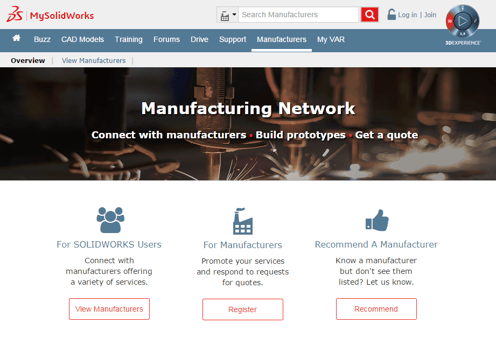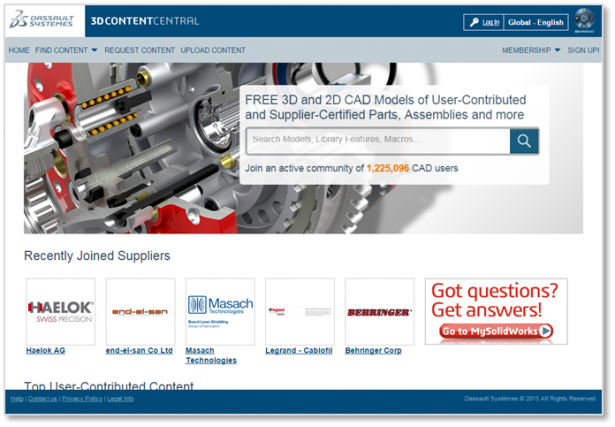With more than 2 million users worldwide, SOLIDWORKS is the largest community in the CAD industry. Judging by their “Amazing Race” or “Black Friday” like speed when the general session doors opened this morning, they might also be the fastest. Today’s General Session, led by Suchit Jain, Vice President Strategy and User Advocacy, honored this community and its amazing work in the fields of design and engineering. From space travel to inspiring the next generation of engineers, today’s general session was proof that this community’s passion is to change the world.
Monica Menghini, EVP, Corporate Strategy, Industry & Marketing, Dassault Systèmes took the stage to discuss how to approach design from a consumer perspective. Today’s challenge is to create products based on the user experience – to not just design products. This era of design extends across an organization from designers and engineers to data experts and business advisers. For this reason, engineering tools must become more collaborative and inclusive of downstream departments.
Next up the SOLIDWORKS User Group Network (SWUGN) leader Richard Doyle took the stage to present this year’s SWUGN awards and pass out free pizza, one of the many benefits of SWUGN meetings.In fact, it was the #1 reason why you should be part of the SWUGN community! Since 1999, SWUGN has been bringing SOLIDWORKS users together to learn from their individual experiences. SWUGN provides an invaluable opportunity to network with peers and partners to elevate your professional development and help your company become more productivity. Now with 247 user groups in 36 countries, chances are, there’s a group near you. If not, you can learn how to start your own local group.
This year’s winners included:
User group of the year:
- San Antonio, Texas, Jim Lowery, Group Leader
User group leaders of the year:
- Don Glaske, Kettle Moraine and Northeast
- Denny Bahl, Chicago and Chicago West
Michelle Pillers Community Award:
- Jeff Mirisola, Jeff’s Tool Shed
Paving the way for the next generation of engineers cannot be overstated. Anyone following the industry’s future understands the critical importance of encouraging students to take up careers in STEM fields. Marie Planchard, Director of Education Community joined the stage to discuss SOLIDWORKS’ efforts to face this challenge – especially when it comes to preparing young women to become leaders in engineering.
Marie reiterated comments covered in yesterday’s keynote address from Bre Pettis: we need more women in engineering. From creating the SOLIDWORKS Women in Engineering program and working with Dartmouth professor Sol Diamond to encourage female designers and entrepreneurs to partnering with FabLabs and First Robotics, Marie let the community know how they too can get involved in educating young women for careers in engineering. These groups are getting young women excited to become engineers and we encourage our community to get involved.
SOLIDWORKS users are sharing the mission to cultivate the next generation of engineers. Roominate, an engineering toy aimed at girls, is one shining example. In the US, less than 15 percent of women enter college intending to major in STEM. The company’s founders believe that this gender disparity begins at a young age. For example, many girls’ toys lag behind in the development of spatial skills, hands-on problem solving skills, and confidence with technology. Roominate Co-founder Bettina Chen arrived to discuss her aim to inspire future innovators at an early age and her experience in founding Roominate. Toys are just the beginning for Bettina, having role models, both male and female, is critical to aspiring engineers. Luckily, there are nearly 6,000 role models in this building who are excited to support the future.
Marie also discussed a key milestone met by the SOLIDWORKS Education team: 2 million licenses of the SOLIDWORKS Education Edition are installed in educational institutions around the world. Read more from Marie on the EDU team’s goal to change how students and educators think about design.
Suchit then rejoined the stage to discuss how SOLIDWORKS plans to educate and train its more than 2.8 million users. Those interested maximizing their SOLIDWORKS knowledge should immediately take advantage of MySolidWorks. MySolidWorks is the online destination for all things SOLIDWORKS including over 500 training sessions, cloud collaboration with MySolidWorks Drive, and answers to questions taken from our forums. Don’t get frustrated to the point where your keyboard is talking to you. Get to MySolidWorks for the answers to solve your CAD problems.
Suchit went on to discuss new MySolidWorks benefits – including the introduction of MySolidWorks’ Manufacturing Network, a portal where users bring their designs to life by easily finding and connecting with reliable manufacturers offering 3D Printing, Sheet Metal, CNC Machining and Injection Molding services. Read more about the MySolidWorks Manufacturing Network launch and how manufacturers, like Proto Labs, are ready to bring designs to life.
As an added bonus, MySolidWorks is offering CSWA prep-courses to all users, at no cost, until March 31st 2015. To be eligible, sign in, complete the courses and you’ll receive a free CSWA exam code. Learn more about the MySolidWorks Manufacturing Network and how you can take advantage of the free CSWA exam offer in this blog post.
Suchit continued on to discuss the new 3D ContentCentral (3DCC) Supplier Services set to launch later this year. Supplier Services through 3DCC was created to make it easier for suppliers to deliver online CAD content to prospects and existing customers. One recent study concluded that nearly 80 percent of buyers who downloaded and incorporated a 3D model from the internet ultimately bought the supplier’s product. 3DCC Supplier Services will allow suppliers to manage and take control of this revenue stream. Read this blog post to learn more about the new 3DCC Supplier Services.
Any engineer can relate to solving design challenges. It’s in their nature to sidestep obstacles no matter how daunting. Suchit then introduced Astrobotic, a company with some unique lunar problems to solve (first moon problems?), to the SOLIDWORKS World stage. If you’re not familiar with Astrobotic, they recently made news by taking home three Google Lunar XPrize milestone awards.
The Lunar XPrize is a new space race pitting eighteen teams from around the world in a competition to land a rover on the moon and move 500 meters on its surface while sending video footage back to earth for us all to enjoy. Think NASCAR on the moon. With a $20 million prize, the stakes are astronomic.
Astrobotic President John Thornton joined Suchit onstage to discuss the unique challenges his team is facing to get from the earth to the moon. The two covered Astrobotic’s plan to take the Griffin Lander to space and complete a four-day mission to the moon. Thornton covered the unique challenges presented by solar radiation and meteorites that can reap havoc on robots. If that sounds challenging enough, Astroboic is landing on Lacus Mortis, aka, the lake of death. Thornton opened the floor to the audience and fielded questions from the Twittersphere that covered gravity’s influence on design and beginning a new era of space travel.
After discussing the moon, it seemed fitting to close day two with a presentation on how technology will change our lives from theoretical physicist, author and professor, Dr. Michio Kaku, who you may recognize as one of New York’s 100 greatest minds (along with Madonna). Over the next thirty minutes, Kaku had the audience rolling in the aisles despite being full of pizza.
Kaku began his talk by talking about the passion to invent and covered some of the more memorable creations including space travel, communications and the internet, which may or may not be a place for high-minded discussion – depending on how many teenagers are using the web at the moment.
Kaku then shared his on the future of the mind. He believes that the power of the mind can bring an era where humans will be able to visualize a product then make it a reality with their mind. How? Moore’s law. Your cellphone has more computing power than Apollo space crafts. Computer power will eventually be everywhere and nowhere, much like electricity. PCs will only be in one place: a museum. In the future the words computer and internet will not exist because these technologies will be ubiquitous.
 Products, like smart contacts, will provide information in the blink of an eye. Students and politicians everywhere will rejoice! This type of innovation will provide a world of augmented reality where language barriers disappear and long-ruined historical sites are resurrected before our eyes. This is leading to the digitalization of life. Soon we’ll all be super humans with x-ray vision and problems, like fat fingers, will no longer plague those struggling with smartphone keyboards.
Products, like smart contacts, will provide information in the blink of an eye. Students and politicians everywhere will rejoice! This type of innovation will provide a world of augmented reality where language barriers disappear and long-ruined historical sites are resurrected before our eyes. This is leading to the digitalization of life. Soon we’ll all be super humans with x-ray vision and problems, like fat fingers, will no longer plague those struggling with smartphone keyboards.
One of the exciting future innovations, especially for those who might have slugged down too much pizza, is robo doc. A super-intelligent, virtual robotic doctor who can diagnose anything from indigestion to more serious cardiac issues. The rise of these virtual docs will lower healthcare costs and ultimately encourage better health by lowering the barrier to medical care.
Kaku then covered innovations in 3D. This starts from 3D TV without glasses and 3D printing, to mass customization. In the future, your exact measurements are available and clothing can be easily created based on your body. No more swimming in extra large SOLIDWORKS World t-shirts. Shirt size ceases to exist and simply becomes your name. Beyond shirts, medicine will also be customized to your being. Pills with cameras will be your first line of defense against disease and medical professionals – allowing them to understand your particular ailments better than ever before.
Naturally, the future of 3D involves design tools. In this case, Kaku discussed how 3D design simulations will create the future of supersonic air travel. Faster than the speed of sound, but without the sonic boom. This technology is in the works and will hopefully make air travel less frustrating for all – or at the very least, it will take less time.
Moving back to the power of the mind, the brain will initiate contact with computers. This was seen first-hand when a paralyzed man blasted the opening kick at the 2014 World Cup with the help of a connected exoskeleton. Another exciting application is recording memories. In the future, you will think, your brain will be scanned and you can print your thoughts. Finally, we can all have photographic memories.
For those in attendance at SOLIDWORKS World, don’t forget to visit the Certified Partner Theater at 1pm MT for what’s to be an exciting Q&A with Michio Kaku.
In what felt as fast as a lunar formula one race, day two of general sessions came to a close. Be sure to check out our other blog posts to stay up to date with #SWW15 news and new product announcements. Remember, you can stream tomorrow’s general session live by registering here and follow the conversation by following #SWW15 on Twitter.
Original Post written by Mike Fearon



SUBMIT YOUR COMMENT